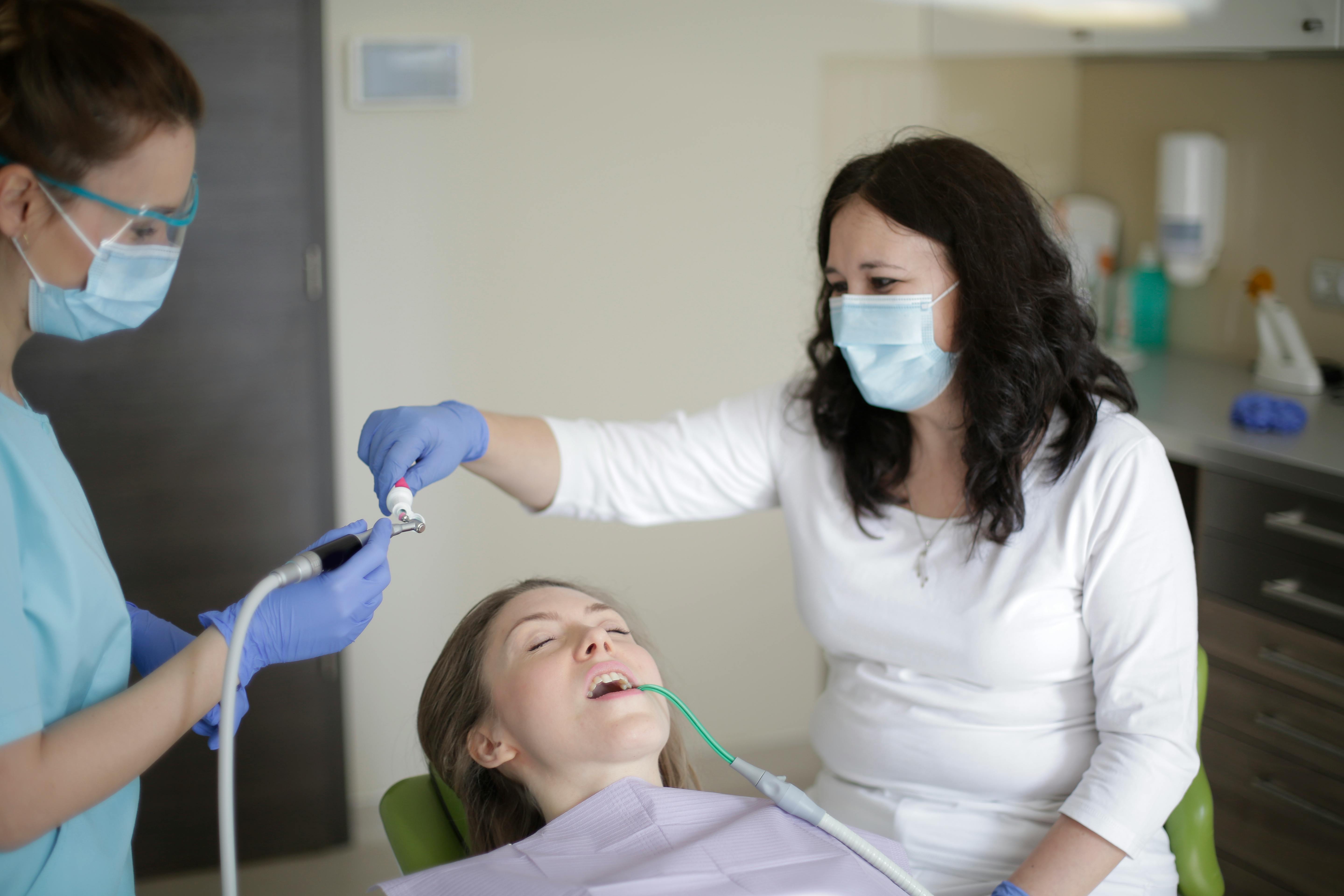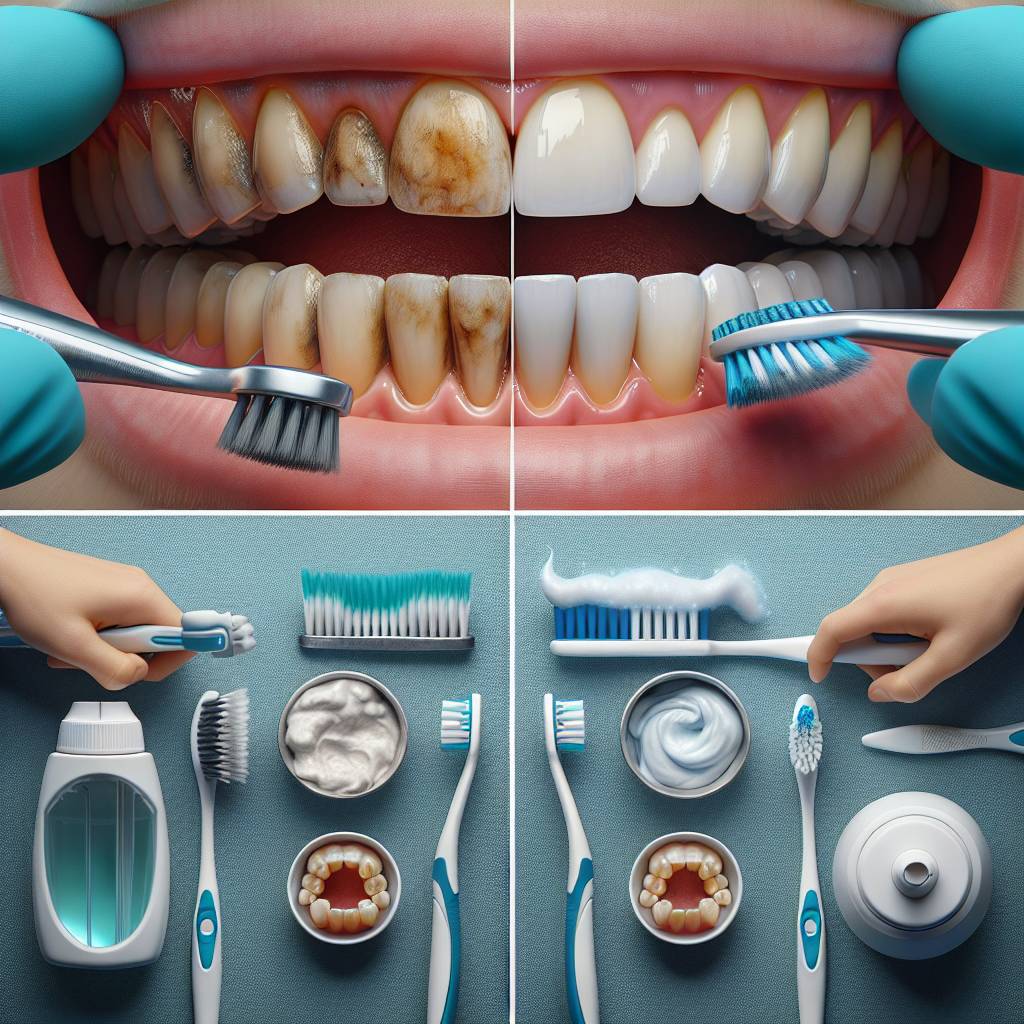Having stained teeth can be embarrassing and often make us feel self-conscious when we smile. Fortunately, there are several methods for removing stains from your teeth. In this article, we will discuss how to get stains off your teeth and provide tips for maintaining a bright, white smile.Brush your teeth twice a day using a fluoride toothpaste. Floss your teeth at least once a day to remove food particles that can lead to staining. Use a whitening toothpaste with baking soda or hydrogen peroxide, which can help remove surface stains. Avoid foods and drinks that can stain your teeth, such as coffee, tea, red wine and dark-colored fruits and vegetables. Rinse your mouth with water after eating or drinking these items to help reduce the risk of staining. Consider an in-office professional teeth whitening treatment if over-the-counter products are not providing the desired results.
1. Professional Teeth Cleaning
Professional teeth cleaning is one of the most effective ways to remove stubborn stains from your teeth. This process involves the use of special tools and techniques to gently remove plaque and tartar build-up from the surface of your teeth. A professional cleaning by a dentist or hygienist can help to reduce the appearance of discoloration and yellowing, giving your smile a much brighter and whiter look.
2. Teeth Whitening
Teeth whitening is also a popular option for removing stains from teeth. This process involves using a bleaching agent to break down stains on the surface of your teeth, resulting in a brighter and whiter smile. Professional whitening treatments are generally more effective than over-the-counter products, as they contain higher concentrations of bleaching agents that are better able to penetrate deep into the enamel to break down stubborn stain particles.
3. Avoid Foods & Drinks That Stain
You can also prevent staining by avoiding certain foods and drinks that have a tendency to discolor your teeth. Coffee, tea, wine, and certain foods such as blueberries are known culprits when it comes to causing staining on your teeth. Limiting or avoiding these types of foods and beverages can help you maintain a bright smile for much longer.
4. Use Straws When Drinking Staining Beverages
If you do choose to indulge in staining beverages such as coffee or tea, try using a straw when you drink them. This will help minimize contact between these beverages and your front teeth, reducing their ability to cause staining over time.
5. Brush With Baking Soda & Hydrogen Peroxide
Another way to remove stains from your teeth is by brushing with baking soda and hydrogen peroxide. Mix together equal parts baking soda and hydrogen peroxide until you form a paste-like consistency, then use this mixture as you would regular toothpaste while brushing your teeth twice daily for best results.
Natural Home Remedies for Teeth Stains
If you are looking for ways to get rid of those stubborn teeth stains, there are many natural home remedies that you can try. One of the most popular remedies is brushing your teeth with baking soda. This will help remove the surface stains on your teeth and leave them looking brighter. You can also add a few drops of hydrogen peroxide to your toothpaste for an extra whitening boost.
Another natural remedy is to rinse your mouth with apple cider vinegar. This will help remove plaque and tartar build up that can cause staining on your teeth. If you don’t like the taste of apple cider vinegar, you can also use lemon juice or even a mixture of both lemon juice and baking soda as a mouth rinse.
Coconut oil pulling is also gaining popularity as a way to combat tooth stains. Coconut oil has antibacterial properties that can help reduce plaque and bacteria in the mouth while removing surface stains. Simply swish one tablespoon of coconut oil in your mouth for 10-20 minutes each day. This helps to pull out any impurities that may be causing the staining on your teeth.
Finally, another great natural remedy is eating crunchy fruits and vegetables such as apples, celery, and carrots. These foods help to scrape away any plaque buildup on your teeth while providing essential vitamins and minerals to keep them healthy and strong. You should also avoid foods high in sugar or acidity as these can contribute to staining over time. By following these simple remedies, you should be able to get rid of those pesky tooth stains and have a brighter smile in no time!
Benefits of Professional Teeth Whitening
Achieving a brighter and whiter smile has become increasingly popular in recent years, and there are a variety of ways to achieve this. Professional teeth whitening is a great solution for those who want to quickly and effectively lighten the shade of their teeth. Professional teeth whitening offers numerous advantages to those looking for a brighter smile.
One advantage of professional teeth whitening is that it produces quick results. Most at-home treatments take several weeks to show any noticeable difference, but professional treatments can typically produce visible results in one session. This is ideal for those who want immediate results, such as before a special event or occasion.
Another benefit of professional teeth whitening is that it can produce more dramatic results than at-home kits. Professional treatments use much higher concentrations of bleaching agents than what is available over-the-counter, allowing for more dramatic color changes in fewer sessions. This makes professional teeth whitening an ideal choice for those with more severe discoloration or staining on their teeth.
Professional teeth whitening is also very safe and effective when performed by a trained dental practitioner. The bleaching agents used by dentists will not damage your enamel or cause any other harm to your mouth; instead they simply lighten the color of your existing tooth enamel without changing its structure or texture in any way.
Finally, professional teeth whitening can help you maintain your desired shade of white by providing touchup treatments when needed. Since the effects of professional tooth whitening tend to last longer than those from at-home treatments, you may only need occasional touchups to keep your smile looking its best over time.
Overall, professional teeth whitening offers numerous advantages over at-home kits, including faster results, more dramatic changes, safety and effectiveness when performed by professionals, and long lasting maintenance options. If you are looking for a safe and effective way to achieve a brighter smile quickly and easily, consider opting for professional tooth whitening services.
Types of Teeth Stains
Teeth staining is a common occurrence for many adults, and can have a number of causes. The two primary types of stains are extrinsic stains, which form on the outer layer of the teeth, and intrinsic stains, which form within the tooth itself. Extrinsic stains are generally easier to remove than intrinsic stains, as they can be removed with professional whitening services or by brushing and flossing regularly. Intrinsic stains may require more specialized treatment.
Extrinsic teeth stains are caused by substances like coffee, tea, red wine, dark-colored foods, tobacco products, and certain medications that accumulate on the surface of teeth over time. In some cases, these can be removed through professional whitening treatments or by brushing and flossing regularly. However, some extrinsic stains may be too deep to be completely removed with these methods.
Intrinsic teeth stains are typically caused by aging or trauma to the tooth enamel. Aging can cause yellowing or discoloration on the surface of the teeth due to the breakdown of enamel over time. Trauma to the tooth enamel can also cause intrinsic staining – for example, a knocked-out tooth may have a grayish hue due to damage to its dentin layer. Intrinsic staining is often more difficult to remove than extrinsic staining and may require more specialized treatments such as veneers or crowns in order to improve its appearance.
In some cases, both intrinsic and extrinsic staining may be present on a single tooth. This is known as combined staining and is usually treated with a combination of professional whitening treatments and restorative dental work in order to restore its natural coloration. It’s important to visit your dentist regularly in order to maintain good oral health and reduce your risk for developing dental problems like cavities or gum disease that can lead to stained teeth.

Foods to Avoid for Whiter Teeth
Having a bright and healthy smile is important, and one way to help maintain it is by avoiding certain foods. Foods that are high in sugar and starch can wear away the protective enamel on your teeth, leading to discoloration. Acidic foods like citrus fruits can also erode enamel, leading to discoloration. To keep your teeth bright and healthy, it’s best to avoid the following:
Soft drinks, such as sodas or energy drinks, are loaded with sugar and acid. The combination of these two can cause erosion of the enamel on your teeth. Instead of soft drinks, opt for water or unsweetened tea.
Coffee and tea are also acidic beverages that can contribute to staining of the teeth. If you do consume these beverages, it’s best to use a straw so that the liquid bypasses your teeth.
Sports drinks may seem like a healthier option than soda but they contain just as much sugar and acid as soda does. It’s best to avoid these beverages if you want whiter teeth.
Citrus fruits such as oranges, lemons, grapefruits and limes are high in acid content which can erode tooth enamel over time if consumed in large quantities. Try incorporating other fruits into your diet instead of relying solely on citrus fruits for vitamin C intake.
White wine is known for its ability to stain the teeth due to its acidic content as well as its color pigment molecules which bind easily with tooth enamel causing discoloration over time. Red wine contains less acid than white wine but both should be consumed sparingly if you’re looking for whiter teeth.
Dark-colored sauces like balsamic vinegar, soy sauce and tomato sauce contain chromogens which attach easily onto tooth surfaces leading to staining over time. If you do consume these sauces or condiments opt for lighter colored varieties instead such as lemon juice or white wine vinegar when possible.
Overall, it’s important to be aware of what you’re consuming when it comes to maintaining a bright and healthy smile. Avoiding certain foods that are high in sugar or acid will help prevent discoloration of the teeth over time.
DIY Teeth Whitening Tips
Having white and clean teeth is becoming increasingly important for many people. Achieving a beautiful smile without spending a fortune on expensive treatments is possible if you know the right DIY teeth whitening tips. Here are some helpful tips to get you started:
Brush your teeth twice a day using a whitening toothpaste. Whitening toothpastes contain special ingredients that can help to remove surface stains and brighten your teeth. Be sure to use a soft-bristled toothbrush so as not to damage your enamel.
Floss regularly to remove plaque and food particles that can cause staining. Flossing helps to keep your mouth healthy and prevents gum disease, which can lead to discolored teeth.
Avoid foods and drinks that are known to stain teeth, such as coffee, tea, red wine, soda, berries, tomato sauce, and beets. If you do consume these items, be sure to brush your teeth afterwards or rinse with water.
Baking soda is an effective remedy for whitening teeth. Use it mixed with water or hydrogen peroxide and brush it onto your teeth with a soft-bristled toothbrush. Rinse thoroughly after brushing with baking soda solution as it can be abrasive on the enamel if left on for too long.
Apple cider vinegar is another natural remedy that can help remove surface stains from the enamel of your teeth. Swish one tablespoon of apple cider vinegar in your mouth for about 30 seconds then rinse with water or brush your teeth afterwards if desired. Do this once or twice a week for best results but avoid using it too often as it may damage the enamel of the tooth over time.
Peroxide is an excellent natural bleaching agent and can help whiten discolored teeth when used correctly in small amounts over time. Mix one part hydrogen peroxide with two parts water and swish in your mouth for 30 seconds then rinse thoroughly with water afterwards or brush if desired. Do this up to three times a week but no more than that so as not to cause any dental sensitivity issues over time due to the acidity of the peroxide solution.
What Causes Tooth Discoloration?
Tooth discoloration is a common problem among people of all ages, and it can have a variety of causes. The most common cause of tooth discoloration is staining from food and drinks like coffee, tea, red wine, and certain fruits and vegetables. Smoking and chewing tobacco can also cause the teeth to become discolored. Poor oral hygiene, certain medications, and some diseases can also lead to tooth discoloration.
Certain types of bacteria in the mouth can produce substances that attach to the teeth and cause them to appear yellow or brown. Poor oral hygiene habits such as not brushing twice daily or flossing at least once a day can allow these bacteria to build up on the teeth and contribute to discoloration.
Medications such as antibiotics, antipsychotics, antihistamines, high blood pressure medications, and chemotherapy drugs can cause stains that are difficult to remove from the teeth. Diseases such as hepatitis or HIV/AIDS can also cause tooth discoloration as well as gum disease which is caused by poor oral hygiene habits.
In some cases genetics may play a role in tooth discoloration; if your parents had discolored teeth you may be more likely to have them too. Age is also a factor; as you get older your enamel begins to thin which allows the dentin underneath it to start showing through making your teeth appear yellow or brown.
No matter what the cause of your tooth discoloration may be there are several ways you can help prevent it or treat it if you already have it. Regular dental visits are essential for maintaining good oral hygiene habits which will help prevent bacteria buildup on your teeth that could lead to discoloration. You should also limit your intake of foods and drinks that tend to stain your teeth such as coffee, tea, red wine, etc., and avoid smoking or chewing tobacco altogether. If you already have stained teeth there are several treatments available from whitening strips or gels at home to professional whitening treatments at your dentist’s office that can help restore the natural whiteness of your smile.

Conclusion
Having a brilliant white smile can provide a great boost to your self confidence. With the right dental hygiene habits and some of the tips discussed above, you can easily stay on top of keeping your teeth clean and looking great. Remember, staining caused by food, beverages, or smoking is natural and will always require regular cleaning for maintenance. It is essential to contact a dentist if you notice any severe yellowing or discoloration in order to receive the best professional advice available.
Keeping your teeth stain-free is not an easy task but with some dedication and effort it can be done. The key is to practice good oral hygiene and use the correct methods for removing those stubborn stains. Regular brushing twice a day, using whitening toothpaste, avoiding certain staining foods and drinks, flossing regularly, using hydrogen peroxide mouthwash, oil pulling with coconut oil or apple cider vinegar, or using baking soda are all effective ways to keep your teeth bright and healthy.
By following the tips above you can be sure that your smile will remain bright and beautiful for years to come!

